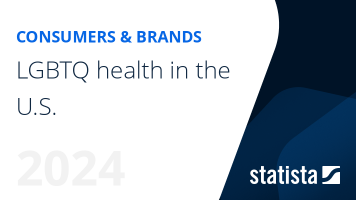LGBTQ+ in the U.S. - statistics & facts
The LGBTQ community in the U.S. has advocated for recognition, acceptance, and the advancement of LGBTQ rights through a variety of movements, organizations, and demonstrations. In response to other notable liberation movements at the time, the Gay Liberation movement emerged in the late 1960s. In June 1969, the Stonewall Inn, a gay bar in New York City, was raided by the police resulting in several nights of LGBTQ activists protesting police brutality. The Stonewall Riots are now considered to be the dawning of the modern LGBTQ rights movement. Since then, LGBTQ communities across the globe continue to host Pride celebrations throughout the month of June.
Demographic Overview
Around 7.6 percent of adults in the United States stated that they identify as LGBT in 2023, which was more than double than in 2012. Of these, roughly 3.3 percent identified themselves as gay or lesbian. The share of U.S. adults identifying as LGBT has risen proportionally to the moral acceptance of gay and lesbian relationships among Americans, which increased from 42 percent to 64 percent in the same period. Furthermore, a person’s gender identity may not be the sex they were assigned at birth. In such instances, some transgender people may choose to transition to affirm their gender identity while others may fall outside of the traditional understanding of gender and identify as non-binary. As of 2021, around 97.4 percent of people assigned female at birth still identified as such.Surveys suggest that young people are considerably more likely to identify with the LGBTQ community. In 2023, 22.3 percent of Generation Z identified as LGBT, more than double than Millennials. The lowest rates fell among older generations, with 2.3 percent of Baby boomers identifying as LGBT. The distribution of LGBT individuals varies between U.S. states, with the most densely populated being the District of Columbia, with 14 percent of D.C. residents identifying as LGBT. Mississippi and North Dakota had the lowest rates, both falling below five percent.
Discrimination
The LGBTQ community in the United States has encountered discrimination in various capacities, leaving LGBTQ individuals particularly vulnerable to restrictive policies and anti-LGBTQ motivated hate crimes. As of 2023, there were 86 anti-LGBTQ hate groups recorded in the U.S., and 1,026 victims of anti-lesbian hate crimes alone that year. Additionally, more than three quarters of Americans believed there to be discrimination against transgender people in the United States. In 2023, 31 transgender and gender-diverse people were murdered in the United States. The majority of anti-LGBTQ hate crimes have occurred in the victims’ homes or places of residence.Policy and Politics
Throughout U.S. history, restrictive legislation has had a profound impact on the LGBTQ community, denying them basic rights and protections. Despite these challenges, there have been a number of legislative wins for the LGBTQ community. Notable legal advancements include the decriminalization of private, consensual sexual activity between same-sex couples, which was federally implemented in 2003, as well as the 2015 Supreme Court decision to legalize same-sex marriage. This ruling has seen continued opposition by many people in the U.S., with 31 percent of Americans in 2022 stating they would like to see same-sex marriage outlawed.LGBTQ policies in the U.S. vary greatly by region, with each state holding responsibility for many individual laws and policies, resulting in some states being more progressive than others when it comes to LGBTQ policy. For example, only 12 states in the U.S. have required law enforcement training to include hate crimes based on sexual orientation and gender identity. When ranked according to seven major policy areas in 2024, California was the state with the highest equality score, and Tennessee the lowest. Differences are also reflected in healthcare access from state to state. As of 2024, 45 percent of the U.S. LGBT population lived in states with transgender exclusions in health insurance coverage.
In recent years, debate surrounding LGBTQ policy has circulated around LGBTQ youth, such as whether or not to include LGBTQ related topics in school curriculum. The mental health of LGBTQ youth has become an increasing concern for many. In 2023, almost half of transgender and non-binary youth considered suicide. A number of U.S. states have also moved toward banning conversion therapy for minors due to its impact on mental health. In 2023, 27 percent of LGBTQ youth in the U.S. who experienced conversion therapy had attempted suicide. As of 2024, 47 percent of the U.S. LGBTQ population were living in states with total bans on conversion therapy.





















































